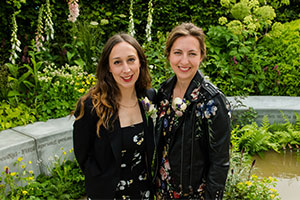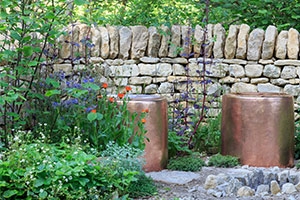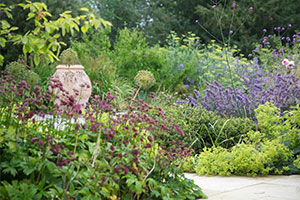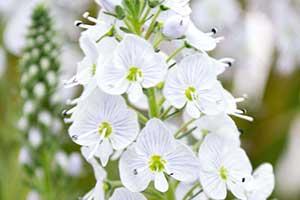Kate Savill and Tamara Bridge brought their beautiful, carefully planned and atmospheric garden designs to the forefront of public attention when they won Channel 5’s The Great Gardening Challenge earlier this year. Here, Kate writes for Garden Trade Specialist about the importance of creating a focal point in a garden and explains how to achieve the look successfully…
A perfectly placed focal point in a garden can really make a space. It’s like sitting a beautiful vase of lilies on a table in a freshly decorated dining room or an expertly chosen piece of art hung on a wall in direct view in of the front door. This touch of finesse can really bring a space alive. It is so important to add these details to create a feeling of finish to the garden and really make it sing.
Just looking down a long vista or walkway to catch a glimpse of a great piece of sculpture can bring a sense of magic and intrigue to a garden. The choice of the right piece is important; it needs to be suitable for your own tastes and sense of style but can also provide you with an opportunity to have some fun.
Enhancing designs for different users 
Tamara and I are incredibly proud of all that we have achieved in creating show gardens and growing our own businesses but something we are most proud of is winning The Great Gardening Challenge. The competition challenged eight pairs of professional garden designers to transform under-used and unloved spaces into gardens to enhance the lives of those around them and was judged by Carol Klein and Mark Gregory. We created three gardens, each within a challenging 48-hour period. The first round was at Norris Green Park in Liverpool, the semi-finals at Glenfield Hospital in Leicester and the competition concluded with a one-off garden at RHS Garden Wisley for the final.
Throughout this competition, Tamara and I explored the ideas of using focal points to enhance our designs. For our first garden build in Liverpool, the challenge was to bring some life into an unloved part of Norris Green Park. The garden needed to be designed for the community to encourage people of all ages to enjoy the space and have sensory elements especially through the planting. We designed a garden around circular central seating with four benches surrounded by lush sensory planting and enclosed by 6 beautiful crab apple trees. We then added lots of fun, maze-like curvy grass paths for the children to run around on.
Right in the centre of the whole garden design, as a focal point within the seating area, we placed a bespoke sinuous concrete bowl planted with a pretty display of pink geraniums. This drew people into the garden and encouraged them to sit and to reflect. The reasons we chose this particular focal point was it tied in with the curves flowing through the whole garden design. It is also robust and offered the opportunity for the garden’s carers – Friends of Norris Green Park – to change the display when they feel it is getting tired and also they can feel like they have control and input into their garden.
This concrete bowl was originally designed as a water feature and focal point for The Jo Whiley Scent Garden (the show garden we designed for the RHS Chelsea Flower Show in 2017). The wonderful Carl, from Chiltern GRC, created our curved concrete bowl using Glass Reinforced Concrete and we were most grateful for all his help and support in developing and realizing the design from the many design sketches and drawings that pinged back and forth. We were really pleased with the final result, which felt so organic but could be used in so many different ways – from planter to water feature. We used it again in the semi-finals as a natural wildlife water bowl with aquatic planting. It is really important to choose an object that is versatile and robust as it will be sat in a garden contending with whatever the weather throws at it. If you can, it’s worth investing a little more to get a quality object to act as your key focal point.
Punctuating with planting 
Of course, plants can be used as a focal point and particularly trees. In the final we used three statement large mature multi-stemmed silver birch trees. They worked as great focal point with their ghostly white stems and architectural presence creating a perfect break and punctuation to the autumnal colours of the rest of the planting.
Tamara and I met in 2015 competing as selected finalists in the RHS Young Designer of the Year Competition. We were building side by side creating our own gardens for the brief of ‘English country gardens’. In Tamara’s design ‘The Sunset Garden’, she achieved a perfect balance of formality and informality (the inspiration for the garden) with beautiful over spilling planting. Using a soft planting style and a colour palatte designed to be most effective when the rich golden rays of the setting sun wash the borders with light, this garden captures the romantic feeling that English gardens are famous for. In the centre of her design, she sourced a stately lichen-covered urn and planted this with Sempervivum Boule de Neige. This proved a very fitting centrepiece for this great English garden and really drew people into the space to be invigorated by the planting.
Finding interesting focal points, pieces of sculpture and planters can sometimes be a challenge but I find that a great place to start if you want something unique or with a bit of history and age is a reclamation or architectural salvage yard.
For my own Young Designer garden, I selected a contemporary take on the traditional physic gardens of medieval England. I wanted to create a serene space and a journey through the garden as you move from an exposed environment to a natural safe haven at its centre. This offered the chance for both engagement and contemplation. All the plants were selected for their medicinal benefits and their beautiful calming shades. Here, in the centre of the garden, I used a large Corten steel circular bowl as my focal point filled to the rim with water. This reflected the light and created a tranquil feeling. It was sourced from Primrose and again has the versatility to be used as a fire pit or planter.
Highlighting the focal point
Someone who expertly uses carefully selected artwork and sculpture in a garden is Italian designer Luciano Giubbilei. He always creates a perfect feeling of balance and harmony by creating modern elegant gardens. He highlights this feeling of balance and restraint by selecting a beautiful piece of sculpture to draw your eye to a certain area of a garden. This creates a chic open-aired green gallery space. He often uses the best of the best in craftsmanship and pays great attention to detail in the sculpture. If this were to be placed in a busy, colourful, perennial-heavy garden it would get totally lost. So to bring more focus to the artwork, his gardens are often just shades of green from trees, shrubs and hedges which keeps the space quiet and still.
In contrast to this, Adam Frost often makes use of a large terracotta pot (pictured) to give a soft romantic feeling to a space conjuring up the feeling of sun-kissed Mediterranean landscapes. This works perfectly surrounded with overflowing planting. A clever trick that Adam uses through his work is to incorporate specific areas to display the focal points into the basic layout of a garden. Another trick that you can use is to slightly extend a path past its destination, giving enough room to put in a statement pot. This will lead the eye down the path and can enhance and elongate a space.
Sometimes the focal point holds a practical use as well as a visual one. In 2018 Tamara and I designed The Warner Edward Garden for RHS Chelsea. Here we used two copper stools as a point of focus, framed by the planting. Copper was used to represent the copper stills at Warner’s gin distillery in Northamptonshire. The light gently reflected off the metallic dimpled surface producing an eye-catching display that captures the audience’s attention and beckoned the viewer into the garden to take a seat and enjoy the view of the botanical planting surrounding the seating area.
Using a piece of shining sculpture can really draw the eye around a garden leading the viewer towards a particular area or to frame a view or give a full stop to a pathway. Whatever your style, there’s a focal point for you and your design. Do think about the placement and what you want to achieve with the space. Adding this final detail which catches and draws the eye can really make all the difference and make your garden stand out from the crowd.
See more of Kate and Tamara’s designs at gardensbykateandtamara.co.uk
Photo: (Norfolk Garden) Adam Frost





